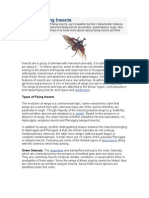Professional Documents
Culture Documents
Illacme Plenipes: Millipedes Are A Group of
Uploaded by
Midhun U KOriginal Description:
Original Title
Copyright
Available Formats
Share this document
Did you find this document useful?
Is this content inappropriate?
Report this DocumentCopyright:
Available Formats
Illacme Plenipes: Millipedes Are A Group of
Uploaded by
Midhun U KCopyright:
Available Formats
Millipedes are a group of arthropods that are characterised by having two pairs of jointed legs on
most body segments; they are known scientifically as the class Diplopoda, the name being derived
from this feature. Each double-legged segment is a result of two single segments fused together.
Most millipedes have very elongated cylindrical or flattened bodies with more than 20 segments,
while pill millipedes are shorter and can roll into a ball. Although the name "millipede" derives from
the Latin for "thousand feet", no known species has 1,000; the record of 750 legs belongs to Illacme
plenipes. There are approximately 12,000 named species classified into 16 orders and around
140 families, making Diplopoda the largest class of myriapods, an arthropod group which also
includes centipedes and other multi-legged creatures.
Most millipedes are slow-moving detritivores, eating decaying leaves and other dead plant matter.
Some eat fungi or suck plant fluids, and a small minority are predatory. Millipedes are generally
harmless to humans, although some can become household or garden pests, especially
in greenhouses where they can cause severe damage to emergent seedlings. Most millipedes
defend themselves with a variety of chemicals secreted from pores along the body, although the
tiny bristle millipedes are covered with tufts of detachable bristles. Reproduction in most species is
carried out by modified male legs called gonopods, which transfer packets of sperm to females.
First appearing in the Silurian period, millipedes are some of the oldest known land animals. Some
members of prehistoric groups grew to over 2 m (6 ft 7 in); the largest modern species reach
maximum lengths of 27 to 38 cm (11 to 15 in). The longest extant species is the giant African
millipede (Archispirostreptus gigas).
Among myriapods, millipedes have traditionally been considered most closely related to the
tiny pauropods, although some molecular studies challenge this relationship. Millipedes can be
distinguished from the somewhat similar but only distantly related centipedes (class Chilopoda),
which move rapidly, are carnivorous, and have only a single pair of legs on each body segment. The
scientific study of millipedes is known as diplopodology, and a scientist who studies them is called a
diplopodologist.
You might also like
- MyriapodsDocument8 pagesMyriapodsGhazal FatimaNo ratings yet
- 28 Orders of InsectsDocument5 pages28 Orders of InsectsJoelben NaresNo ratings yet
- GrasshoppersDocument8 pagesGrasshoppersleonel ocanaNo ratings yet
- Research ProjectDocument1 pageResearch ProjectUtterlyBastardGroovyNo ratings yet
- Anoplura: DermapteraDocument15 pagesAnoplura: DermapterajessicaNo ratings yet
- Phylum AnnelidaDocument6 pagesPhylum AnnelidaRechelle CabagingNo ratings yet
- Annelids TriviaDocument2 pagesAnnelids TriviaRommel Urbano YabisNo ratings yet
- InsectsDocument3 pagesInsectsStephen KuiraNo ratings yet
- Animals: by Melwin MarkDocument69 pagesAnimals: by Melwin MarkMelwinNo ratings yet
- About BatDocument16 pagesAbout BatRiswan Hanafyah HarahapNo ratings yet
- Arthropod: Animal Kingdom Lobsters Crabs Spiders Mites Insects Centipedes MillipedesDocument14 pagesArthropod: Animal Kingdom Lobsters Crabs Spiders Mites Insects Centipedes MillipedesAljofebes Ceniza ObedenciaNo ratings yet
- Ants Are Formicidae And, Along With The Related: Superfamily PapilionoideaDocument4 pagesAnts Are Formicidae And, Along With The Related: Superfamily PapilionoideaLogu12345No ratings yet
- The Book of Caterpillars: A Life-Size Guide to Six Hundred Species from Around the WorldFrom EverandThe Book of Caterpillars: A Life-Size Guide to Six Hundred Species from Around the WorldDavid G. JamesRating: 4.5 out of 5 stars4.5/5 (4)
- Invertebrates AntonetteDocument27 pagesInvertebrates Antonetteduganirene1No ratings yet
- ArthropodsDocument8 pagesArthropodsLearn To EarnNo ratings yet
- Animal Kingdom ClassificationDocument20 pagesAnimal Kingdom Classificationsarvesh672No ratings yet
- AntsDocument21 pagesAntsSerajul SalekinNo ratings yet
- Vertebrates Fertilization Development Scales Turtles Tuatara Lizards Snakes Crocodiles Birds Archosauria BirdDocument8 pagesVertebrates Fertilization Development Scales Turtles Tuatara Lizards Snakes Crocodiles Birds Archosauria BirdJhuliane RalphNo ratings yet
- Project Ni ArlyDocument15 pagesProject Ni ArlyAnthony Tunying MantuhacNo ratings yet
- Protozoa: Protozoa (From The Greek Words Proto, Meaning "First", and Zoa, Meaning "Animals") Is A GroupingDocument8 pagesProtozoa: Protozoa (From The Greek Words Proto, Meaning "First", and Zoa, Meaning "Animals") Is A Groupinggabrielluis08No ratings yet
- Reptiles and Their Descendance From DinosaursDocument2 pagesReptiles and Their Descendance From DinosaurshubertusNo ratings yet
- Grasshopper: Grasshoppers Grasshoppers Are A Group of Insects Belonging To The SuborderDocument20 pagesGrasshopper: Grasshoppers Grasshoppers Are A Group of Insects Belonging To The SuborderAAREEZ IMRAANNo ratings yet
- Best Control For FliesDocument30 pagesBest Control For FliesDavidNo ratings yet
- CaterpillarDocument8 pagesCaterpillarRengeline LucasNo ratings yet
- MegaBat SpeciesDocument3 pagesMegaBat SpeciesbasogNo ratings yet
- Familiarity With The TwentyDocument6 pagesFamiliarity With The TwentyNoieme AndayaNo ratings yet
- Biology Assignment: Submitted To: Sir Khan Submitted By: Talha Rafiq Class: 8 Date of Submission: February 8, 2015Document5 pagesBiology Assignment: Submitted To: Sir Khan Submitted By: Talha Rafiq Class: 8 Date of Submission: February 8, 2015Talha RafiqNo ratings yet
- Arthropoda Lecture - 2023Document13 pagesArthropoda Lecture - 2023BHEKUMUSA MASEKONo ratings yet
- Insects and Arachnids : Animal Books for Kids | Children's Animal BooksFrom EverandInsects and Arachnids : Animal Books for Kids | Children's Animal BooksNo ratings yet
- Sloth: This Article Is About The Central and South American Mammal. For The Cardinal Sin, See - For Other Uses, SeeDocument6 pagesSloth: This Article Is About The Central and South American Mammal. For The Cardinal Sin, See - For Other Uses, SeeAlexandra LicaNo ratings yet
- STB 211 Pest and Pest ControlDocument57 pagesSTB 211 Pest and Pest ControlDaniel50% (2)
- Animal Diversity - The Kingdom Animalia 1. Phylum Porifera - SpongesDocument6 pagesAnimal Diversity - The Kingdom Animalia 1. Phylum Porifera - SpongesSamantha Dasmariñas MagaanNo ratings yet
- Guico - Phylum Arthropoda (Seatwork 1)Document2 pagesGuico - Phylum Arthropoda (Seatwork 1)aeprintsNo ratings yet
- Etymology: Taxonomy and EvolutionDocument6 pagesEtymology: Taxonomy and EvolutionMithileshsingh94No ratings yet
- KNOWN INSECTS OF UNKNOWN WORLD BioDocument12 pagesKNOWN INSECTS OF UNKNOWN WORLD BioSayan LodhNo ratings yet
- By Deasia TuckerDocument18 pagesBy Deasia Tuckerapi-269363156No ratings yet
- Lab 5 - ArthropodsDocument12 pagesLab 5 - ArthropodsObi GoodnessNo ratings yet
- Sci 8 4TH Quarter Module 6Document35 pagesSci 8 4TH Quarter Module 6Diosa BakingNo ratings yet
- Types of Invertebrates AnimalsDocument1 pageTypes of Invertebrates AnimalsMikaela Angela EsporlasNo ratings yet
- HummingbirdsDocument6 pagesHummingbirdsதுளசி இன்போஸ்No ratings yet
- LepidepteraDocument41 pagesLepidepteraSaid H AbdirahmanNo ratings yet
- BATS! The Only Flying Mammals | Bats for Kids | Children's Mammal BooksFrom EverandBATS! The Only Flying Mammals | Bats for Kids | Children's Mammal BooksNo ratings yet
- Sloths (:, 1842 and Davies, 1795Document2 pagesSloths (:, 1842 and Davies, 1795Hershey Cordero BrionesNo ratings yet
- Classifying InvertebratesDocument9 pagesClassifying InvertebratesKurt EmmañuelNo ratings yet
- The PseudocoelomatesDocument8 pagesThe Pseudocoelomatessteanne100% (1)
- Janitor FishDocument2 pagesJanitor FishXyprexia DependentNo ratings yet
- ReptileDocument4 pagesReptileDratonius 101No ratings yet
- Myriapods and Their Biological ClassificationDocument2 pagesMyriapods and Their Biological ClassificationNilanka HarshaniNo ratings yet
- Lab 8 Arthro PDFDocument9 pagesLab 8 Arthro PDFAtin FifaNo ratings yet
- Group 3: Kingdom AnimaliaDocument23 pagesGroup 3: Kingdom AnimaliabrettNo ratings yet
- Report of Analysis Animal Comparison Analysis Between: Grasshopper and DamselfliesDocument10 pagesReport of Analysis Animal Comparison Analysis Between: Grasshopper and DamselfliesReynanda ApriliaNo ratings yet



























































